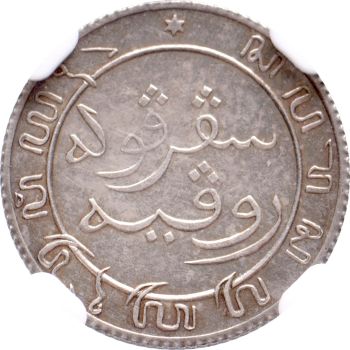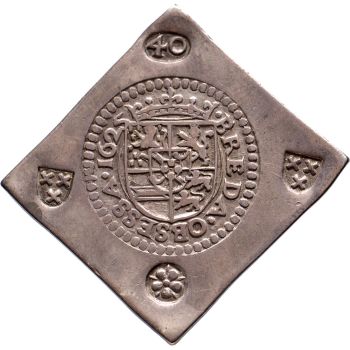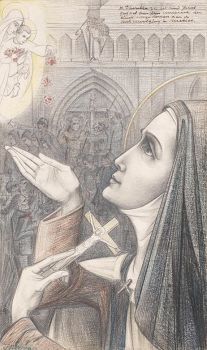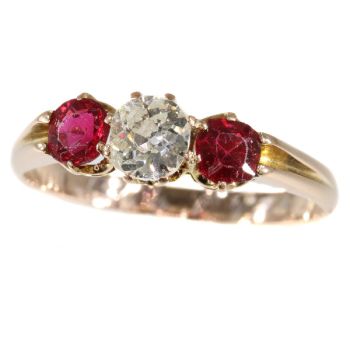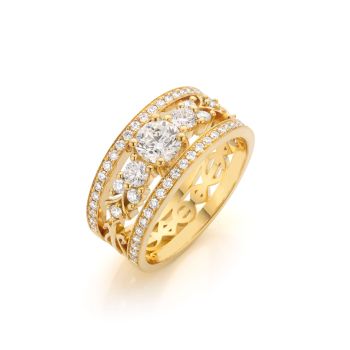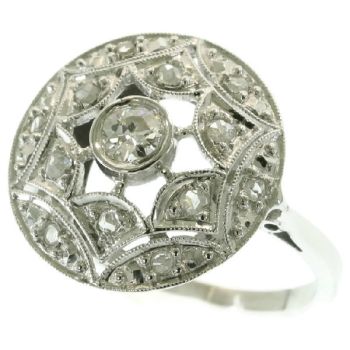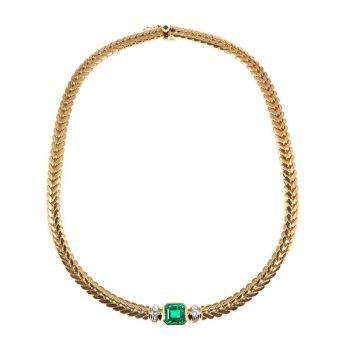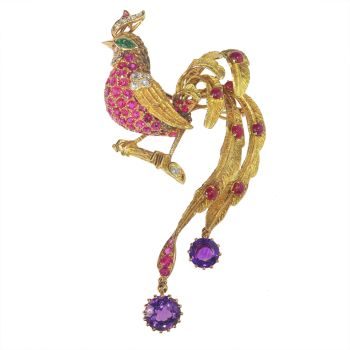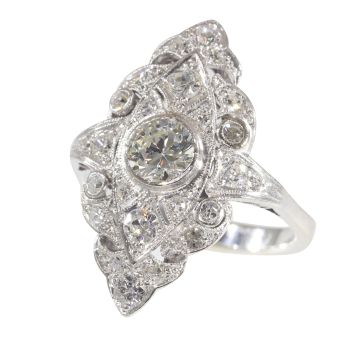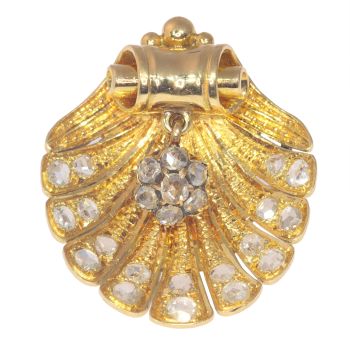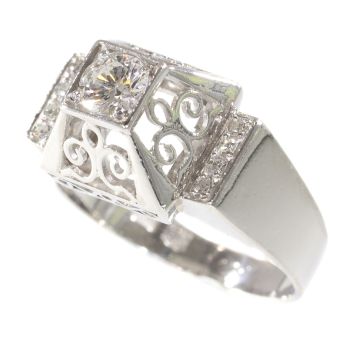Antique French cross Badine" with large rose cut garnets made shortly after French Revolution" 1810
Artiste Inconnu
Or jaunediamantGrenatOrGemme
€ 9.250
Adin Fine Antique Jewellery
- Sur l'oeuvre d'art
Antique jewelry object group
pendant
Condition
very good condition
more info on our condition scale
Country of origin
France
Style
Empire - The Empire style, sometimes considered the second phase of Neoclassicism, is an early-19th-century design movement in architecture, furniture, other decorative arts, and the visual arts followed in Europe and America up to around 1830. The style originated in and takes its name from the period when Napoleon I ruled France, known as the First French Empire, where it was intended to idealize Napoleon's leadership and the French state. The style corresponds to the Biedermeier style in the German-speaking lands, Federal style in the United States and to the Regency style in Britain. An earlier phase of the style was called the Adam style in Great Britain and "Louis Seize" or Louis XVI, in France.
See also: Empire
more info on styles
Style specifics
A style that borrowed style specifics from the ancient Greeks and the Roman empire (hence the name of the style: Empire). The empire period represents the second part of the Neo-Classical style, and shows a strong French influence. The style originated in the desire of Napoleon to revive the luxurious majesty of imperial Rome. Traditional classical motifs, already seen in the reign of Louis XVI, were supplemented by symbols of imperial grandeur- the emperor's monogram and his emblem, the bee; representations of military trophies; and after the successful campaigns in Egypt, Egyptian motifs. If we had to characterize this style briefly, we could focus on two elementary concepts: massiveness and symmetry.
Period
ca. 1810
Events & facts of this era, poetry of this era, fashion of this era.
Source of inspiration
Christianity
Theme
Cross - The cross is one of the most ancient human symbols, and is used by many religions, such as Christianity. It is frequently a representation of the division of the world into four elements (or cardinal points), or alternately as the union of the concepts of divinity, the vertical line, and the world, the horizontal line. (from: Wikipedia)
Material
18K yellow gold (touchstone tested)
more info on precious metals
Technique
The rose cuts are set on foil. This is a special technique that was used to bring the lustre of the diamonds to its best quality.
Extra information
Cross pendant "Badine" or little wind in gold with garnets, pear-shaped element articulated to the rest of the cross, in bezel setting, with bail drawn back and invisible. This cross was the most typical and traditional cross made in the Roussillon in France, worn with a silk or velvet ribbon attached or tied around the neck. The shape of this jewel was already know by Catalan goldsmiths in 1663. Worn during the Empire and the Restoration, they are found on the portrait of Elizabeth Campagnac. In our days, French regional crosses are very scarce compared to the variety that existed in the old days. Most of these crosses are now kept in museums or in private collections.
Precious stones
14 rose cut garnets
Birthstones
Garnet is the birthstone (or month stone) for January.
more info on birthstones
Hallmarks
The French hallmark depicting a rooster's head which was used in France for 18K gold around 1810.
more info on hallmarks
Dimensions
height 6,13 cm (2,41 inch)
see picture with a ruler in millimeters and inches
Weight
12,30 gram (7,91 dwt)
Adin Reference Nº
22354-0097
Copyright photography
Adin, fine antique jewellery
Additional information
our latest acquisitions
jewelry glossary
wall of fame
visit us in Antwerp
subscribe to our mailinglist
- Sur l'artiste
Il peut arriver qu'un artiste ou un créateur soit inconnu.
Certaines œuvres ne doivent pas être déterminées par qui elles sont faites ou elles sont faites par (un groupe d') artisans. Les exemples sont des statues de l'Antiquité, des meubles, des miroirs ou des signatures qui ne sont pas claires ou lisibles, mais aussi certaines œuvres ne sont pas signées du tout.
Vous pouvez également trouver la description suivante :
•"Attribué à …." A leur avis probablement une oeuvre de l'artiste, au moins en partie
•« Atelier de …. ou « Atelier de » À leur avis, une œuvre exécutée dans l'atelier ou l'atelier de l'artiste, éventuellement sous sa direction
•« Cercle de… ». A leur avis une oeuvre de la période de l'artiste témoignant de son influence, étroitement associée à l'artiste mais pas forcément son élève
•« Style de … ». ou "Suiveur de ...." Selon eux, une œuvre exécutée dans le style de l'artiste mais pas nécessairement par un élève ; peut être contemporain ou presque contemporain
•« Manière de… ». A leur avis une oeuvre dans le style de l'artiste mais d'une date plus tardive
•"Après …." A leur avis une copie (quelle qu'en soit la date) d'une oeuvre de l'artiste
•« Signé… », « Daté… ». ou « Inscrit » À leur avis, l'œuvre a été signée/datée/inscrite par l'artiste. L'ajout d'un point d'interrogation indique un élément de doute
• "Avec signature ….", "Avec date ….", "Avec inscription …." ou "Porte signature/date/inscription" à leur avis la signature/date/inscription a été ajoutée par quelqu'un d'autre que l'artiste
Êtes-vous intéressé par l'achat de cette oeuvre?
Artwork details
Related artworks
- 1 - 4 / 12
Artiste Inconnu
Set Franse Empire Pendules / Empire Lectura penduleearly 19th
Prix sur demandeKuipers Kunst & Antiek
Artiste Inconnu
Bracelet en diamant du XVIIIe siècle avec intailles vieilles de 2000 ans1790
€ 23.000Adin Fine Antique Jewellery
 Sélectionné par
Sélectionné parDanny Bree
1 - 4 / 14- 1 - 4 / 24
- 1 - 4 / 24
Jean-Claude Champagnat
French 18K gold vintage 1960's bejeweled bird of paradise brooch by Jean-Claude Champagnat1960
€ 12.500Adin Fine Antique Jewellery
 Sélectionné par
Sélectionné parDanny Bree
1 - 4 / 24- 1 - 4 / 12







